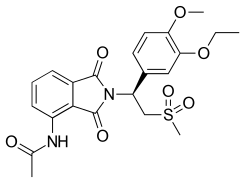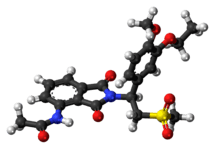Apremilast
Apremilast, sold under the brand name Otezla among others, is a medication for the treatment of certain types of psoriasis and psoriatic arthritis. It may also be useful for other immune system related inflammatory diseases. The drug acts as a selective inhibitor of the enzyme phosphodiesterase 4 (PDE4) and inhibits spontaneous production of TNF-alpha from human rheumatoid synovial cells.[5] It is taken by mouth.[6]
 | |
 | |
| Clinical data | |
|---|---|
| Pronunciation | /əˈprɛmɪlæst/ ə-PREM-i-last |
| Trade names | Otezla, Aplex, others |
| Other names | CC-10004 |
| AHFS/Drugs.com | Monograph |
| MedlinePlus | a614022 |
| License data |
|
| Pregnancy category | |
| Routes of administration | By mouth (tablets) |
| ATC code | |
| Legal status | |
| Legal status | |
| Pharmacokinetic data | |
| Bioavailability | 73%;[3] Tmax = ~2.5 hours |
| Protein binding | c. 68%[3] |
| Metabolism | Liver (CYP3A4, with minor contributions from CYP2A6, CYP1A2)[3] |
| Metabolites | O-desmethylapremilast glucuronide (and others)[4] |
| Elimination half-life | 6–9 hours[3] |
| Excretion | Urine (58%), faeces (39%)[3] |
| Identifiers | |
| |
| CAS Number | |
| PubChem CID | |
| DrugBank | |
| ChemSpider | |
| UNII | |
| KEGG | |
| ChEBI | |
| ChEMBL | |
| CompTox Dashboard (EPA) | |
| ECHA InfoCard | 100.234.786 |
| Chemical and physical data | |
| Formula | C22H24N2O7S |
| Molar mass | 460.50 g·mol−1 |
| 3D model (JSmol) | |
| |
| |
Medical uses
Apremilast is indicated in the United States for the treatment of adults with active psoriatic arthritis, the treatment of people with moderate to severe plaque psoriasis who are candidates for phototherapy or systemic therapy, and the treatment of adults with oral ulcers associated with Behçet's Disease.[6]
In the European Union, Apremilast alone or in combination with disease-modifying antirheumatic drugs (DMARDs), is indicated for the treatment of active psoriatic arthritis (PsA) in adults who have had an inadequate response or who have been intolerant to a prior DMARD therapy.[7] It is also indicated for the treatment of moderate to severe chronic plaque psoriasis in adults who failed to respond to or who have a contraindication to, or are intolerant to other systemic therapy including cyclosporine, methotrexate or psoralen and ultraviolet-A light (PUVA).[7]
Contraindications
In the European Union, the drug is contraindicated during pregnancy because mice and monkeys receiving very high doses of apremilast have been observed to suffer miscarriages and other pregnancy problems.[4] In the U.S., it may be used for pregnant women "if the potential benefit justifies the potential risk to the fetus".[1]
Adverse effects
Diarrhea and vomiting
Diarrhea occurs in about 25% of people taking apremilast. Severe gastrointestinal symptoms, when they occur, typically start within the first few weeks of treatment.[8][9]
Psychological
Worsening depression, suicidal thoughts, and other mood changes may occur with apremilast.[6]
Weight loss
Weight loss: Weight loss has been associated with apremilast. Reports from clinical studies indicated a 5 to 10% decrease in body weight in 10% of patients taking apremilast (compared to 3.3% of patients taking placebo).[6]
Other
Common, usually mild to moderate adverse effects associated with apremilast include headache, back pain, nausea, diarrhea, fatigue, nasopharyngitis and upper respiratory tract infections.[10]
Interactions
Concurrent use of strong cytochrome P450 enzyme inducers has been shown to decrease exposure of apremilast and can result in reduced or loss of efficacy of apremilast. It is not recommended to use simultaneously with strong P450 enzyme inducers, including rifampicin, phenobarbital, carbamazepine, phenytoin,[6] and St. John's Wort.[11]
Pharmacology
Mechanism of action
Apremilast is a small molecule inhibitor of PDE4,[6] an enzyme that breaks down cyclic adenosine monophosphate (cAMP).[6] In inflammatory cells, PDE4 is the dominant enzyme responsible for this reaction. The resulting increase in cAMP levels down-regulates expression of a number of pro-inflammatory factors like tumor necrosis factor alpha (TNFα), interleukin 17, interleukin 23, and many others, and up-regulates the anti-inflammatory interleukin 10. In ex vivo models of arthritis, IL-12/IL-23p40 was specifically identified as a downstream target of apremilast.[12] The importance of these individual factors for the clinical effect of apremilast is not clear.[4]
Pharmacokinetics
Apremilast is absorbed from the gut well (73%) and independently of food intake, and reaches peak blood plasma concentrations after 2.5 hours. Plasma protein binding is 68%. It is metabolised in the liver, mainly via the enzyme CYP3A4, but to a minor extent via CYP1A2 and CYP2A6. The main metabolite is O-desmethylapremilast glucuronide.[3][4]
The half-life is 6–9 hours. The substance is eliminated through the kidney (58%) and feces (39%), mainly in form of its metabolites. Only 3% of the original substance are found in the urine, and 7% in the feces.[3][4]
Chemistry
Apremilast is a phthalimide derivative. It is a white to pale yellow, non-hygroscopic powder that is practically insoluble in water and buffer solutions in a wide pH range, but is soluble in lipophilic solvents such as acetone, acetonitrile, butanone, dichloromethane, and tetrahydrofuran.[13]
In vitro, apremilast reduces PDE4 activity leading to an increase in cyclic-adenosine monophosphate (cAMP) concentrations in immune and non-immune cell types, partially inhibiting the production of many pro-inflammatory cytokines such as TNF-α, IFN-γ IL-2, IL-12 and IL-23 and elevating the production of the anti-inflammatory cytokine IL-10.[14][15] The inhibition potency of apremilast in TNF-α production is similar to lenalidomide.[16]
Celgene reported seven kinds of crystal form A, B, C, D, E, F, and G and thought the crystal form B was the most thermodynamically stable anhydrous form. However, Utopharm reported another more thermodynamically stable anhydrous crystal form II than the crystal form B.[17]
Accessibility
Otezla is available in the U.S., but is dispensed only through a network of specialty pharmacies.[18] The estimated wholesale price is $22,500 for a year of treatment.[19] In Austria, the drug is available in all pharmacies, and a year of treatment costs health insurances about €11,000.[20]
History
Apremilast was approved by the US Food and Drug Administration (FDA) in 2014, for treatment of adults with active psoriatic arthritis and moderate to severe plaque psoriasis, and approved in 2019, for oral ulcers associated with Behçet's disease.[18][21][22] Apremilast is taken by mouth.[19]
Apremilast was approved for use in the European Union in January 2015.[7]
In 2019, Amgen acquired Otezla from Celgene for US$13.4 billion.[23]
See also
- Discovery and development of thalidomide and its analogs
References
- "Apremilast (Otezla) Use During Pregnancy". Drugs.com. 27 September 2019. Retrieved 19 April 2020.
- "Otezla 30 mg Film-Coated Tablets - Summary of Product Characteristics (SmPC)". (emc). 15 April 2020. Retrieved 19 April 2020.
- "Otezla (aprelimast) dosing, indications, interactions, adverse effects, and more". Medscape Reference. WebMD. Retrieved 28 March 2014.
- Haberfeld H, ed. (2015). Austria-Codex (in German). Vienna: Österreichischer Apothekerverlag.
- Apremilast
- "Otezla- apremilast tablet, film coated Otezla- apremilast kit". DailyMed. 26 February 2020. Retrieved 19 April 2020.
- "Otezla EPAR". European Medicines Agency (EMA). Retrieved 19 April 2020.

- Kavanaugh A, Mease PJ, Gomez-Reino JJ, Adebajo AO, Wollenhaupt J, Gladman DD, et al. (March 2015). "Longterm (52-week) results of a phase III randomized, controlled trial of apremilast in patients with psoriatic arthritis". The Journal of Rheumatology. 42 (3): 479–88. doi:10.3899/jrheum.140647. PMID 25593233.
- Stein Gold L, Bagel J, Lebwohl M, Jackson JM, Chen R, Goncalves J, et al. (February 2018). "Efficacy and Safety of Apremilast in Systemic- and Biologic-Naive Patients With Moderate Plaque Psoriasis: 52-Week Results of UNVEIL". Journal of Drugs in Dermatology. 17 (2): 221–228. PMID 29462231.
- Mease PJ, Armstrong AW (March 2014). "Managing patients with psoriatic disease: the diagnosis and pharmacologic treatment of psoriatic arthritis in patients with psoriasis". Drugs. 74 (4): 423–41. doi:10.1007/s40265-014-0191-y. PMC 3958815. PMID 24566842.
- "Otezla Product Monograph" (PDF). Celgene Canada. Celgene Corporation. Archived from the original (PDF) on 7 April 2015. Retrieved 3 April 2015.
- Kragstrup TW, Adams M, Lomholt S, Nielsen MA, Heftdal LD, Schafer P, Deleuran B (2019). "ex vivo models of arthritis". Therapeutic Advances in Musculoskeletal Disease. 11: 1759720X19828669. doi:10.1177/1759720X19828669. PMC 6391542. PMID 30833991.
- "Assessment report for Otezla" (PDF). EMA. 20 November 2014.
- Schafer P (June 2012). "Apremilast mechanism of action and application to psoriasis and psoriatic arthritis". Biochemical Pharmacology. 83 (12): 1583–90. doi:10.1016/j.bcp.2012.01.001. PMID 22257911.
- Schafer PH, Parton A, Gandhi AK, Capone L, Adams M, Wu L, et al. (February 2010). "Apremilast, a cAMP phosphodiesterase-4 inhibitor, demonstrates anti-inflammatory activity in vitro and in a model of psoriasis". British Journal of Pharmacology. 159 (4): 842–55. doi:10.1111/j.1476-5381.2009.00559.x. PMC 2829210. PMID 20050849.
- Michelli ML (2011). Liver cirrhosis : causes, diagnosis, and treatment. New York: Nova Biomedical Books. ISBN 978-1-61209-248-5.
- "A novel stable and non-solvate crystal form II on Apremilast and processes for the preparation thereof". Utopharm. 18 April 2015. Archived from the original on 31 May 2015.
- "Oral Otezla (apremilast) Approved by the U.S. Food and Drug Administration for the Treatment of Patients with Moderate to Severe Plaque Psoriasis" (Press release). Celgene Corporation. 23 September 2014. Retrieved 29 October 2014.
- Apremilast for the Treatment of Psoriatic Arthritis American College of Rheumatology (14 June 2014). Retrieved 29 October 2014. Archived 21 February 2015 at the Wayback Machine
- "Warenverzeichnis" (in German). I. Österreichischer Apothekerverlag. January 2016. Cite journal requires
|journal=(help) - "FDA approves Otezla to treat psoriatic arthritis". U.S. Food and Drug Administration (FDA) (Press release). 21 March 2014. Archived from the original on 13 February 2017. Retrieved 19 April 2020.

- "FDA Approves OTEZLA (apremilast) for the Treatment of Oral Ulcers Associated with Behçet's Disease". Celgene Corporation (Press release). 19 July 2019. Archived from the original on 19 April 2020. Retrieved 11 November 2019.
- "Amgen To Acquire Otezla For $13.4 Billion In Cash Or Approximately $11.2 Billion Net Of Anticipated Future Cash Tax Benefits". Amgen, Inc. 26 August 2019. Retrieved 19 April 2020.
External links
- "Apremilast". Drug Information Portal. U.S. National Library of Medicine.